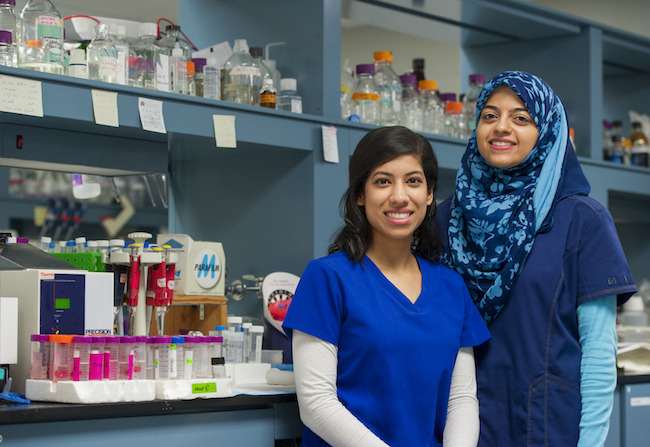A taste of research: Part 3

Research took center stage this summer for participants in the Predoctoral Student Research Program at Texas A&M College of Dentistry, who spent eight weeks working in labs around campus. For a behind-the-scenes glimpse, we asked three groups of student researchers to give us their take on their experiences. Enjoy Part 3 of this three-part series.

Salma Haneef and Syeda Jafri
Faculty mentor: Dr. Amal Noureldin, clinical assistant professor in public health sciences
Instead of the usual summer activities, second-year students Salma Haneef and Syeda Jafri spent their break in the lab of Dr. Amal Noureldin studying one material’s remineralization properties.
“The students are involved in testing a novel biomimetic material that is formulated to regenerate decayed enamel,” says Noureldin. “We are working to treat the white spot lesion that is a big challenge to all the dental community, especially following orthodontic treatment.”
The students gained hands-on experience that led to valuable insights.
“Enamel itself is a non-vital tissue without the ability to regenerate,” explains Haneef. “This poses a problem in dentistry when cavities form due to the demineralization of enamel on the tooth surface. However, there are other possible solutions to help create remineralization.”
One of these is Curodont, a gel that quickly forms an active regenerative layer over enamel and exposed dentin and tubuli to create a scaffold upon which mineral deposition can occur.
“We investigated potential barriers that would hinder the Curodont from penetrating the tooth surface,” Jafri says. “For example, brushing with over-the-counter toothpaste creates a calcium fluoride reservoir on the tooth surface that would potentially affect the Curodont’s effectiveness.” Two additional possible barriers are the salivary pellicle – the protein film that forms on the surface enamel upon contact with saliva – and hydroxyapatite toothpaste, Jafri says.
“Our research aims to discover which of these would pose the greatest hindrance to Curodont penetration, so we can learn the necessary pre-treatment steps to eliminate the barrier and create maximum potential for this scaffold to form,” the students say.
The findings revealed that any residual material on the tooth affects the penetration of the peptide Curodont. This supports the use of removing residual material to allow the Curodont to penetrate as deeply as possible.
“It’s been rewarding to take part in a project that has important clinical implications,” the students say. “Curodont is currently used in Europe as a treatment for patients who have cavitated lesions. Depending on the final results of this study, there could be changes in how the tooth is prepared prior to the application of Curodont.”
For Noureldin, aside from the knowledge her students acquire from their specific research investigation, she wants them to walk away from their experience with a determination that will impact their future endeavors.
“I always hope that my research team gains one major thing: GRIT,” she says. “I love the fact they learn that nothing will be achieved without trying and trying, trial and error, and trouble shooting.”